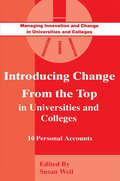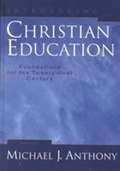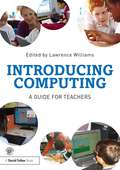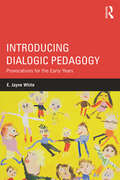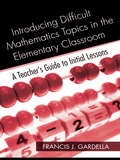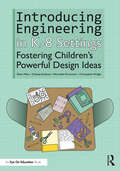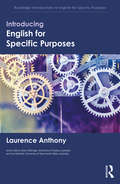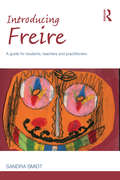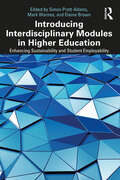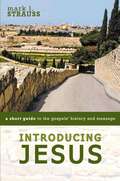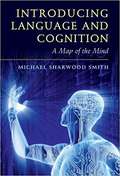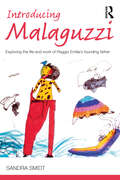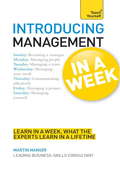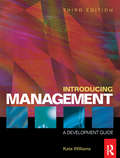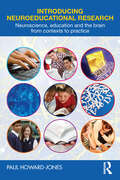- Table View
- List View
Introducing Change from the Top in Universities and Colleges: Ten Personal Accounts (Managing Innovation And Change In Universities And Colleges Ser.)
by Susan WeilPart of a series reflecting the recent changes in further and higher education, this volume relates the true stories of 10 educational managers and their experiences of recent events. The managers tell how they have maintained direction and impact, balanced pressures and set up their own systems.
Introducing Christian Education: Foundations of the 21st Century
by Michael J. AnthonyMichael Anthony offers Introducing Christian Education to fill the need in the C.E. curriculum for an introductory foundations textbook--one that provides an overview and understanding of the broad range of subjects included in C.E.--for college and seminary use.
Introducing Computing: A guide for teachers
by Lawrence WilliamsThis timely new text provides an accessible introduction to teaching Computing, and computer programming. Specifically designed for non-specialists who need to develop new skills in Computing in order to meet the new curriculum requirements, it offers a useful guide to the subject, alongside worked examples of good practice. Packed full of practical advice, the book examines different approaches to introducing children from age 5 to Computing, and describes a wide range of tried and tested projects that have been proven to work in schools. Including case studies and a glossary of key terms, it covers: The key concepts in Computing and computational thinking Using personal learning networks, social media and the 'wiki curriculum' to develop higher thinking skills and desirable learner characteristics Links to the curriculum at Key Stages 1, 2 and 3 Practical ways to develop children’s Computing skills alongside creative writing, art and music Gaming and computer science Featuring a companion website www.literacyfromscratch.org.uk with extensive support materials, examples of pupils’ work, links to software and downloadable lesson plans, this is an essential text for all teachers and trainees who are responsible for the new Computing curriculum.
Introducing Dialogic Pedagogy: Provocations for the Early Years
by E. Jayne WhiteIntroducing Dialogic Pedagogy presents some of the ideas of Russian philosopher Mikhail Bakhtin concerning dialogism in a way that will engage and inspire those studying early childhood education. By translating the growing body of dialogic scholarship into a practical application of teaching and learning with very young children, this book provides readers with alternative ways of examining, engaging and reflecting on practice in the early years to provoke new ways of understanding and enacting pedagogy. This text combines important theoretical ideas with a practical application to support practitioners who are keen to promote creativity and agency through ethical self-other relations. It provides unique insights into the amazing world of the youngest child, and offers enriched understandings of the profound impact of adults in their journey of becoming (or bildung). Key points covered include: Investigating dialogic philosophy and its application to early childhood education, with an emphasis on notions of justice, democracy, ethics and answerability Considering the relationship between dialogism and pedagogical approaches Theorising a range of approaches to relevant early childhood practice, as pedagogy This accessible and readable guide offers sound theoretical principles with practical suggestions for early years’ settings. The book is supplemented by an extensive online video resource website that will bring these revolutionary ideas to life. .
Introducing Difficult Mathematics Topics in the Elementary Classroom: A Teacher’s Guide to Initial Lessons
by Francis J. GardellaThis exciting text for the pre-service elementary teacher provides hands on mathematics lessons they can use to introduce mathematical concepts and skills that students find particularly challenging. Each chapter is divided into four sections: The Activity employs an engaging thought experiment to help the reader "visit a classroom" to understand how the lesson used to introduce the concept or skill would materialize in the class. The Mathematics provides the necessary mathematical background used in the lesson to make the actual teaching/learning situation comfortable for both the teachers and the learner. The Plan provides the reader with an actual lesson plan to engage the Activity in the classroom setting. Putting It All Together pulls the previous sections together with a summary of the chapter as well as further information for making the lesson successful. By providing models of what excellent lessons on a given topic look like, knowledge of the mathematics involved, and a concrete lesson plan structure this much-needed resource is the definitive mathematics planning vehicle that every teacher will want before they set foot in their own elementary classroom.
Introducing Emotional Freedom Techniques
by Moran ChristineThis title offers simple and effective techniques for emotional health and wellbeing. Emotional Freedom Techniques (EFT) is an energy therapy that is rapidly gaining recognition as a simple, yet very effective way to aid emotional and physical wellbeing. The techniques empower individuals to make their own changes in their thinking and feeling, by combining focus on an issue whilst tapping on the body's energy system. EFT provides highly flexible, easy-to-use and practical solutions for a huge range of emotional issues across all age groups. This book is a comprehensive information resource and 'how to' guide for health professionals and adults to introduce EFT into their day-to-day lives. It provides an extensive exploration of how EFT can be successfully applied to a wide range of social, emotional, behavioural and health issues. It includes case examples of phobias, fears, issues around behaviour, confidence, health issues, speech problems, depression, stress, anger, addictions, abuse, performance issues and managing pain. It offers an overview of some of the latest perspectives within neuroscience and physiology which reflect the changes that occur naturally when using EFT.
Introducing Engineering in K-8 Settings: Fostering Children's Powerful Design Ideas
by Christopher Wright Elissa Milto Chelsea Andrews Merredith PortsmoreIntroducing Engineering to K-8 Students will provide you with the tools you need to incorporate engineering design into your classroom. Rather than prescribing a specific curriculum to follow, this book will help you engage your students with hands-on, open-ended engineering design problems that can be easily integrated into your existing classroom setup.Beginning with the basics of K-8 engineering, and advancing to topics such as integrating engineering with other disciplines, documentation, and assessments, the chapters provide a how-to on creating open-ended engineering activities, design tasks, and projects that are reflective of the academic, social, emotional, developmental, and community goals of your students. An additional focus is on ways to adapt these pedagogical approaches to meet the needs of all students, representative of racially, ethnically, socioeconomically, and gender diverse populations and students who receive special education services. Case studies and practical implementation strategies are presented alongside more than fifteen lesson plans, with tips on how to modify the tasks presented in the book to work with your classroom and students. This user-centered approach will also help you create your own engineering lessons that meet your individual classroom objectives and interests, and be able to recognize and classify your students’ engineering behaviors to support them in enacting their ideas.No matter your experience or comfort level, this book will be an invaluable resource for elementary and middle school science and technology teachers at all career stages who are looking to introduce engineering design to their students.Additional classroom resources can be found online at introducingengineering.org.
Introducing English Studies
by Tonya Krouse and Tamara F. O’CallaghanFrom literary studies to digital humanities, Introducing English Studies is a complete introduction to the many fields and sub-disciplines of English studies for majors starting out in the subject for the first time. <P> The book covers topics including: <BR> history of English language and linguistics <BR> literature and literary criticism <BR> cinema and new media Studies <BR> composition and rhetoric <BR> creative and professional writing <BR> critical theory <BR> digital humanities <P> The book is organized around the central questions of the field and includes case studies demonstrating how assignments might be approached, as well as annotated guides to further reading to support more in-depth study. A glossary of key critical terms helps readers locate essential definitions quickly when studying and writing and revising essays
Introducing English as an Additional Language to Young Children: A Practical Handbook
by Kay Crosse`A definite must-have for all teachers of English confronted with early multilingualism′ - Times Educational Supplement The activities and guidance in this book will help teachers to develop the confidence and meet the individual needs of young children with English as an additional language across different settings. There are also practical and varied language teaching strategies to promote learning for children working individually or in small groups. The first part of the book focuses on the introduction and development of oral language skills and the particular needs of young "additional English language learners" settling into a new environment. It provides an introduction to the Foundation Stage curriculum and the ways in which links can be made with English as an additional language activity. The second part of the book presents practical activities grouped under the six areas of learning forming the early years curriculum. Each activity includes an appropriate objective, materials and preparation, key vocabulary to focus on and extension suggestions, as well as full guidance on how to manage the activity effectively. The book will be a valuable resource for all teachers, teaching assistants and other early years staff in day nurseries, nursery schools and other early years settings. Kay Crosse is a freelance early years consultant and was formerly head of Norland College.
Introducing English for Specific Purposes (Routledge Introductions to English for Specific Purposes)
by Laurence AnthonyIntroducing English for Specific Purposes presents the key concepts and practices of ESP in a modern, balanced, and comprehensive way. This book defines ESP and shows how the approach plays a crucial role in the world of English language teaching. Explaining how needs analysis, language and learning objectives, materials and methods, and evaluation combine to form the four main pillars of ESP, the book includes: practical examples that illustrate how the core theories and practices of ESP can be applied in real-world academic and occupational settings; discussion of some of the most hotly debated issues in ESP; insights on how ESP courses can be organized and integrated to form a complete program; reflection boxes, practical tasks, extension research questions, and resources for further reading in each chapter. Introducing English for Specific Purposes serves as an ideal textbook for graduate and advanced undergraduate students studying courses on English for Specific Purposes or English for Academic Purposes, as part of degrees in English for Specific Purposes, Education, ELT, Applied Linguistics, TESOL or TEFL. This comprehensive publication is also an invaluable reference resource for pre-service and in-service teachers of ESP, and for English program managers and administrators.
Introducing Freire: A guide for students, teachers and practitioners (Introducing Early Years Thinkers)
by Sandra SmidtThe famous Brazilian educator Paulo Freire has influenced educators, teachers and students in a broad tapestry of contexts and countries, as he challenged conventional thinking on how teachers ought to teach and learners ought to learn. By making his ideas accessible and relevant, this insightful and thought-provoking text draws out the relevance and topicality of Freire’s work and applies this to a wide range of educational settings, from adult education, through schools, to early years settings. Themes covered include: the lasting impact of illiteracy; the benefits and potential in becoming literate; literacy, language and power; the differences between banking and dialogic education; the social and political nature of learning. what kind of teaching and learning do we want? Using a variety of practical examples and case studies, Introducing Freire is an essential guide to the work of one of the most significant figures in education in the last century. Fascinating and accessible, this book is for anyone interested in teaching and learning, poverty and affluence, power and powerlessness, and society and change.
Introducing Genre and English for Specific Purposes (Routledge Introductions to English for Specific Purposes)
by Sunny HyonGenre analysis has become a key approach within the field of English for Specific Purposes and helps students understand particular language use patterns in target contexts. Introducing Genre and English for Specific Purposes provides an overview of how genre has been conceptualized and applied in ESP, as well as the features that distinguish ESP genre research and teaching from those of other genre schools. The macro and micro aspects of ESP genre-based pedagogy are also analysed and include: different possibilities for planning and designing an ESP genre-based course; the concrete, micro aspects of materials creation; and how genres can be learned through play. Introducing Genre and English for Specific Purposes is essential reading for students and pre-service teachers who are studying Genre, English for Specific Purposes or language teaching methodologies.
Introducing Interdisciplinary Modules in Higher Education: Enhancing Sustainability and Student Employability
by Elaine Brown Mark WarnesThis interdisciplinary book uses key examples and specific case studies from the ‘Trailblazers’ of Anglia Ruskin University, UK, to address the successes and challenges experienced during the creation, development, and running of breadth modules. It’s been carefully written to support anyone looking to implement this innovative method into their own university setting.With content informed by the United Nations Sustainable Development Goals, and using active learning pedagogies, interdisciplinary student teams work together to develop sustainable solutions, allowing for the growth of skills vital for enhancing student employability. The chapters are grounded in theory, making the discussions transferable to a wide readership interested in interdisciplinary approaches at the higher education level. The theoretical underpinnings of the discussions in each chapter will open up questions relating to contemporary issues such as diversity and representation, poverty and sustainability, artificial intelligence, and social justice.This is a must-read text for anyone seeking to implement similar breadth modules at their institutions, or considering how to develop strategies that address whole institution questions such as sustainability and employability.
Introducing Jesus: A Short Guide to the Gospels' History and Message
by Mark L. StraussTo Christians worldwide, the man Jesus of Nazareth is the centerpiece of history, the object of faith, hope, and worship. Even those who do not follow him admit the vast influence of his life. For anyone interested in knowing more about Jesus, study of the four biblical Gospels is essential.An abridged edition of the bestselling textbook Four Portraits, One Jesus by Mark Strauss, this simple, easy-to-understand guide introduces the four biblical Gospels and their subject, the life and person of Jesus.Like different artists rendering the same subject using different styles and points of view, the Gospels paint four distinctive portraits of the same remarkable Jesus. With clarity and insight, Mark Strauss addresses questions that surround the study of Jesus and the Gospels. What are the Gospels - are they history, theology, biography? Where did they come from? What do we know about their context? What does each Gospel uniquely teach us about Jesus? Finally, he pulls it all together illuminating what the Gospels together teach about Jesus' ministry, message, death, and resurrection, and how do we know we can trust their witness.Including questions at the end of each chapter for group discussion or personal reflection, Introducing Jesus makes the words, history, and context of the Gospels come alive for readers.
Introducing Judaism
by Eliezer SegalIntroducing Judaism is the ideal starting point for students beginning their studies of this fascinating religion. Eliezer Segal takes a historical approach, focusing on religious aspects of Judaism, and introducing themes as they emerge from authentic Jewish documents. Students will gain an understanding of how Judaism is lived by its adherents and the historical and geographical diversity of Jewish beliefs and practices. The book has a clear and accessible structure. Part One presents the historical context of Judaism, from the Biblical era, through the Medieval period and on to modern Judaism. Part Two surveys the distinctive values and beliefs of Judaism, including attitudes to God, Covenant, Israel, exile and homeland, the Torah, and its commandments, while Part Three presents Jewish Practices and Institutions, engaging with topics such as daily life, worship, temple and synagogue, law, ethics and education, the afterlife, and resurrection. Throughout the book, Eliezer Segal stresses the diversity of interpretations that have been generated by historical circumstances, differing theological and ideological outlooks, and the spiritual creativity of the religious community. Attention is paid to various models of piety, mysticism, scholasticism, and folk religion, including the impact of Judaism on the daily life of believers and the experiences of Jewish women. Illustrated throughout, Introducing Judaism includes text boxes, a glossary, and a list of further reading to aid students’ understanding and revision, providing a thorough overview of one of the first recorded monotheistic faiths and one of the oldest religions still practiced today.
Introducing Language and Cognition
by Smith Michael SharwoodIn this accessible introduction, Mike Sharwood Smith provides a working model or 'map' of the mind, with language as its centrepiece. Drawing on cutting-edge research across linguistics, psychology and neuroscience, it allows students to quickly grasp how each separate aspect of the mind's operations can be related. This 'big picture' view includes the way the mind makes, stores and loses memories of all kinds as well how its various 'expert systems' combine and collaborate to solve, typically beyond our conscious awareness, the myriad of tasks we are faced with every minute and millisecond of our existence. The book also focuses on language, that is, the mind of monolingual, bilingual and multilingual speakers. It will be of interest to all students wishing to learn more about the complex relationship between language - one of the most important ways in which we define ourselves as human - and the mind.
Introducing Malaguzzi: Exploring the life and work of Reggio Emilia’s founding father (Introducing Early Years Thinkers)
by Sandra SmidtLoris Malaguzzi is recognised as the founder of the extraordinary programmes of preschool education that developed after the war in Reggio Emilia, Italy. Deeply embedded in the cultures and communities they serve, these unique preschools have justifiably become famous throughout the world. In this accessible and engaging text, Sandra Smidt examines how Malaguzzi’s philosophy developed out of his personal experiences of growing up in post-fascist Italy. His ideas are explored and illustrated throughout by examples relating to everyday early years practice. The key themes explored include: relationships — the importance of relationships, culture and contexts to learning within any setting and beyond; transparency — the importance of listening and documentation to understanding and sharing learning; questioning — inviting children to not only answer questions but raise them, allowing them to be equal partners in all learning situations; creativity — finding ways of enabling children to use all the expressive languages they can find to express and share their ideas; equity and fairness — involving the community in all decision-making and discussions, to ensure that early childhood education is accessible and relevant to all children.? This book will be of benefit to all those working with young children and essential reading for students on early childhood education programmes.
Introducing Management in a Week: Teach Yourself
by Martin ManserThe ability to make a successful transition into management who wants to advance their career.Written by Martin Manser, a leading trainer of managers and highly-respected author, this book quickly teaches you the insider secrets you need to know to in order to seamlessly move up the career ladder.The highly motivational 'in a week' structure of the book provides seven straightforward chapters explaining the key points, and at the end there are optional questions to ensure you have taken it all in. There are also cartoons and diagrams throughout, to help make this book a more enjoyable and effective learning experience.So what are you waiting for? Let this book put you on the fast track to success!
Introducing Management: A Development Guide
by Kate WilliamsNow fully revised and in its third edition, this comprehensive best-selling text, Introducing Management: A Development Guide, explains the principles and practice of management and is ideal for both new and existing managers to assist them in their role. The text incorporates the latest innovations in management thinking and reflects the changes within the management standards. This is an essential resource for those undertaking qualifications at S/NVQ at Level 3.The learning development is clearly structured in each chapter to include:-Objectives, Insights, Case Studies, Examples, Review Your Learning, Back to Work, allowing the user to check their understanding and apply the concepts and principles to their own work situation.
Introducing Neuroeducational Research: Neuroscience, Education and the Brain from Contexts to Practice
by Paul Howard JonesAmongst educators, scientists and policy-makers there is a growing belief that the field of education can benefit from an understanding of the brain. However, attempts to bring neuroscience and education together have often been hampered by crucial differences in concepts, language and philosophy. In this book, Paul Howard-Jones explores these differences, drawing on the voices of educators and scientists to argue for a new field of enquiry: neuroeducational research. Introducing Neuroeducational Research provides a meaningful bridge between two diverse perspectives on learning. It proposes that any such bridge must serve two goals that are critically related to each other: it must enrich both scientific and educational understanding. This challenge gives rise to unique conceptual, methodological and ethical issues that will inevitably characterise this new field, and these are examined and illustrated here through empirical research. Throughout the book, Paul Howard-Jones: Explores ‘neuromyths’ and their impact on educational research Highlights the opportunities to combine biological, social and experiential evidence in understanding how we learn Argues against a ‘brain-based’ natural science of education Introduces clearly the concept of an interdisciplinary neuroeducational approach Builds a methodology for conducting neuroeducational research Draws on case studies and empirical findings to illustrate how a neuroeducational approach can provide a fuller picture of how we learn. Presenting a blueprint for including our knowledge of the brain in education, this book is essential reading for all those concerned with human learning in authentic contexts: educators, scientists and policy-makers alike.
Introducing Neuroeducational Research: Neuroscience, Education and the Brain from Contexts to Practice
by Paul Howard JonesAmongst educators, scientists and policy-makers there is a growing belief that the field of education can benefit from an understanding of the brain. However, attempts to bring neuroscience and education together have often been hampered by crucial differences in concepts, language and philosophy. In this book, Paul Howard-Jones explores these differences, drawing on the voices of educators and scientists to argue for a new field of enquiry: neuroeducational research. Introducing Neuroeducational Research provides a meaningful bridge between two diverse perspectives on learning. It proposes that any such bridge must serve two goals that are critically related to each other: it must enrich both scientific and educational understanding. This challenge gives rise to unique conceptual, methodological and ethical issues that will inevitably characterise this new field, and these are examined and illustrated here through empirical research. Throughout the book, Paul Howard-Jones: Explores ‘neuromyths’ and their impact on educational research Highlights the opportunities to combine biological, social and experiential evidence in understanding how we learn Argues against a ‘brain-based’ natural science of education Introduces clearly the concept of an interdisciplinary neuroeducational approach Builds a methodology for conducting neuroeducational research Draws on case studies and empirical findings to illustrate how a neuroeducational approach can provide a fuller picture of how we learn. Presenting a blueprint for including our knowledge of the brain in education, this book is essential reading for all those concerned with human learning in authentic contexts: educators, scientists and policy-makers alike.
Introducing Nonroutine Math Problems to Secondary Learners: 60+ Engaging Examples and Strategies to Improve Higher-Order Problem-Solving Skills
by Robert LondonOffering secondary math educators an innovative holistic and process-orientated approach for implementing nonroutine problems into their curriculum, this book defines and establishes practical strategies to develop students’ problem-solving skills. The text focuses on the process skills necessary to solve nonroutine problems in mathematics and other subjects, with the goal of making students better problem-solvers both in and outside of the classroom. Chapters present and define a curriculum of over 60 nonroutine problems in mathematics and other content areas, and explore the pedagogy to implement this type of curriculum consistent with the NCTM Standards and Principles to Action. Four different models of implementation are discussed, alongside a structured approach through seven difficulty levels (with examples), to ensure that every student, independent of their mastery of mathematics content, can improve their ability to solve nonroutine problems. It emphasizes to students how to transfer their problem-solving skills to other real-world areas, including increasing ecological awareness, appreciating diversity and addressing significant and meaningful problems in their life, school and community. The curriculum introduced in this book can be included as a component of a traditional four-year academic high school curriculum aligned with the Common Core Mathematical Practices, or as part of a one-year isolated required or elective mathematics course. Based on extensive field-testing this approach has been effective in both traditional mathematics courses and math electives such as a course in Problem-Solving. This book provides the necessary guidance to allow each mathematics teacher to effectively integrate the approach in their classrooms. This book is ideal for secondary mathematics teachers of all levels, as well as teachers of mathematics electives.
Introducing Paul: The Man, His Mission and His Message
by Michael F. BirdMany Christians who know and love the Bible think they know the apostle Paul. He's a theological master, a pastoral mentor, a spiritual adviser and a missionary hero. Yet just when we think we have him in our grasp, he slips through our fingers. At the point where we suppose we have finally understood him, Paul again confounds us. But he also beckons us to explore God's ways more deeply. Michael Bird suggests that if the Paul we claim to know looks and sounds a lot like us, it's probably a warning light that we don't know him as well as we think we do. But if we let Paul be Paul, allowing him to speak for himself in his language, on his terms and for his purposes, then we stand a chance of meeting him anew. Introducing Paul is an animated and penetrating survey of Paul's life and teaching. It covers all the basics students need, while offering new insights with a light touch. Blending life and study, Bird aims to get us excited about reading Paul's letters, sharing his gospel and living the Christian life the way he thought it should be lived. For beginning students and laypeople, Introducing Paul is a valuable entrance into the contemporary study of Paul.
Introducing Piaget: A guide for practitioners and students in early years education (Introducing Early Years Thinkers)
by Ann Marie Halpenny Jan PettersenJean Piaget was one of the most significant contributors to our current understanding of how children think and learn, from birth through to adolescence. In this comprehensive and accessible new book, Ann Marie Halpenny and Jan Pettersen capture the key concepts and principles of Piaget’s fascinating work on children’s thinking, and explore how thinking evolves and develops from infancy through the early years and beyond. Areas covered in Introducing Piaget include: key milestones and achievements in children’s thinking; understanding the physical world through senses and movement in infancy; supporting the emergence of symbolic thought and language in the early years; understanding object permanence; implications of egocentric thinking in early childhood learning and development. Throughout the book, the consequences of these developments for children’s social, emotional and intellectual development are discussed. Updates on Piaget’s theory are also outlined with reference to more recent work on cognitive development in childhood. Each chapter provides a concise summary of material presented through a consideration of the implications for practice in working with children. A glossary of key Piagetian terms is also included. With a particular focus on how Piaget’s principles and concepts can be applied to children in early childhood, this exciting new book is an invaluable resource for teachers, practitioners and students with an interest in learning and development in the early years.
Introducing Research in Early Childhood
by Polly Bolshaw Jo Josephidou“What a useful book for the beginner researcher! Offering a grounding in the different kinds of research conducted in the field of early childhood, this book’s inviting and accessible style will support the novice researcher, and the development of criticality in relation to research.” Deborah Albon, Senior Lecturer in Early Childhood Studies, University of Roehampton What does the term ‘research’ in early childhood actually mean? What does research involve, and how do you go about doing it? This book explains exactly what ‘research’ is; it explores key ideas, themes and terminology to provide you with a clear understanding of its importance to your early years or early childhood studies degree. It will help you: · Understand what it means to think critically, and unpick childhood research · Learn how to analyse, examine and understand the importance of others’ research · Get to know how research is designed and carried out · Appreciate the importance of ethics · Get to grips with translating research into real life in an early childhood setting. Laying the foundations to develop your confidence in talking about research and making links between theory and practice, this book will support you as you begin your research journey into the world of early years. Polly Bolshaw is a Senior Lecturer in Early Childhood Studies at Canterbury Christ Church University. Jo Josephidou is a Senior Lecturer in Early Childhood Studies at Canterbury Christ Church University.
